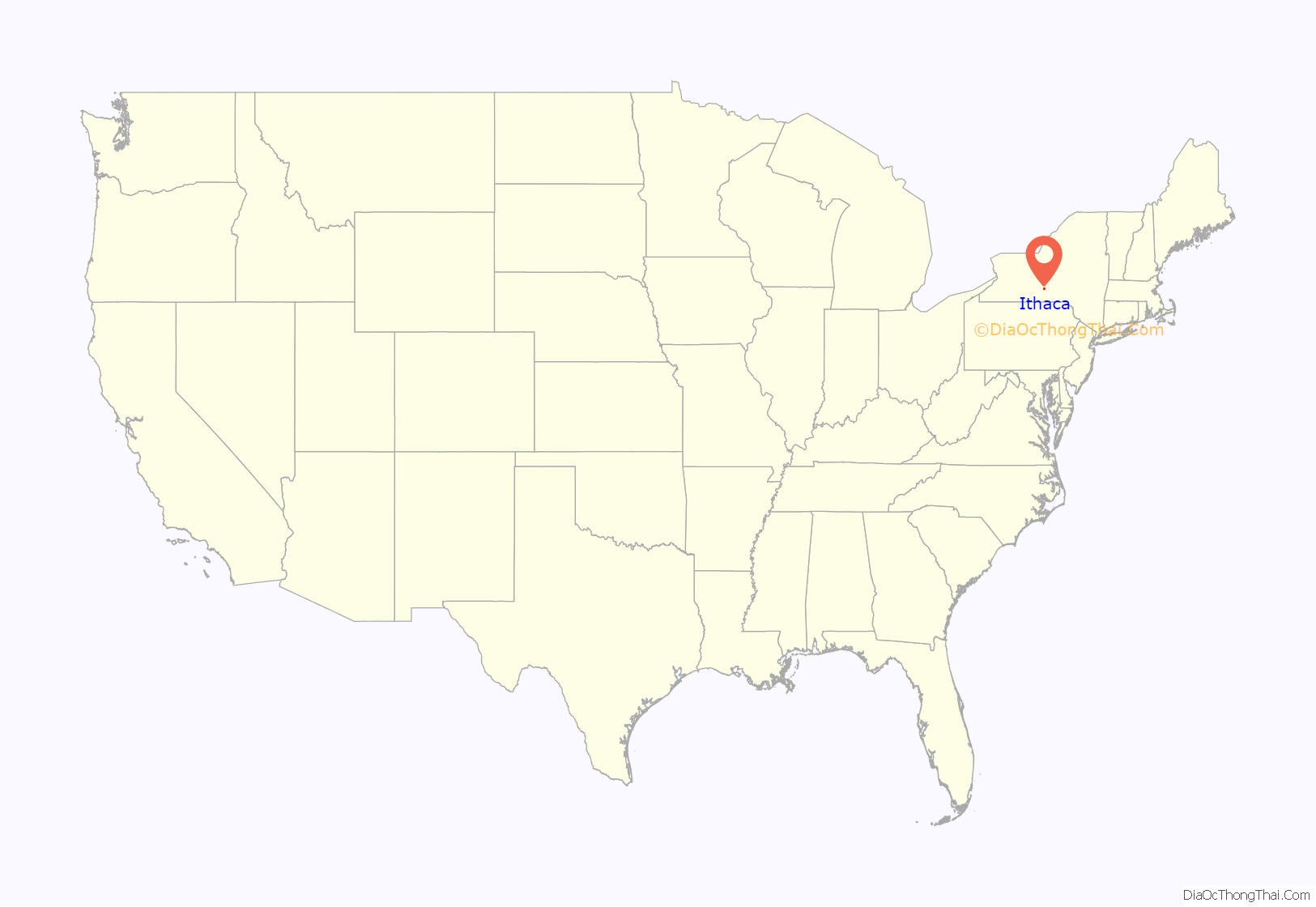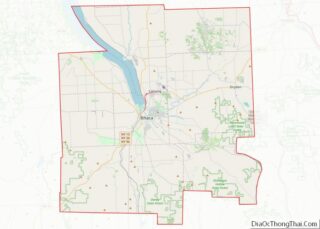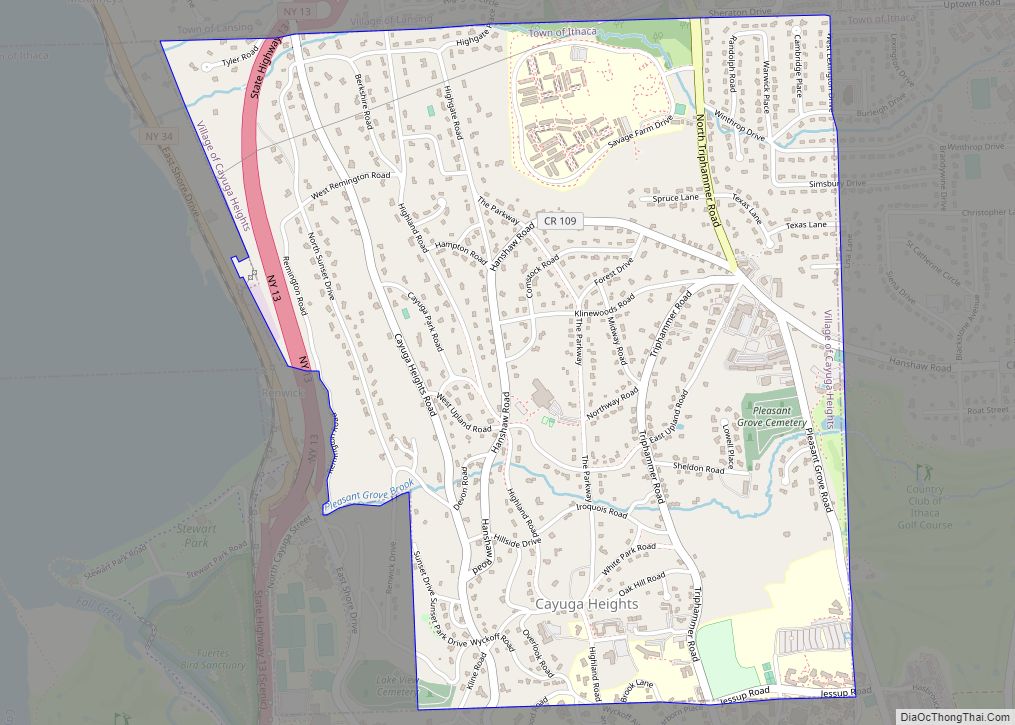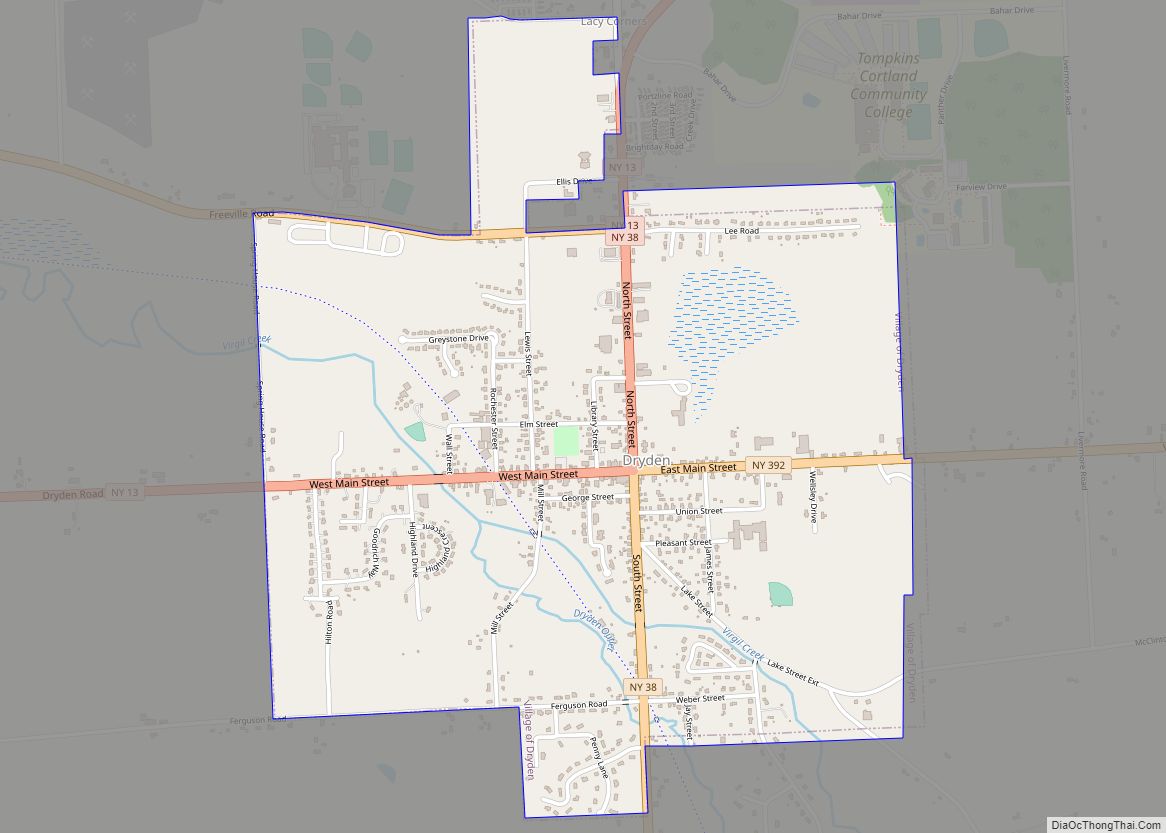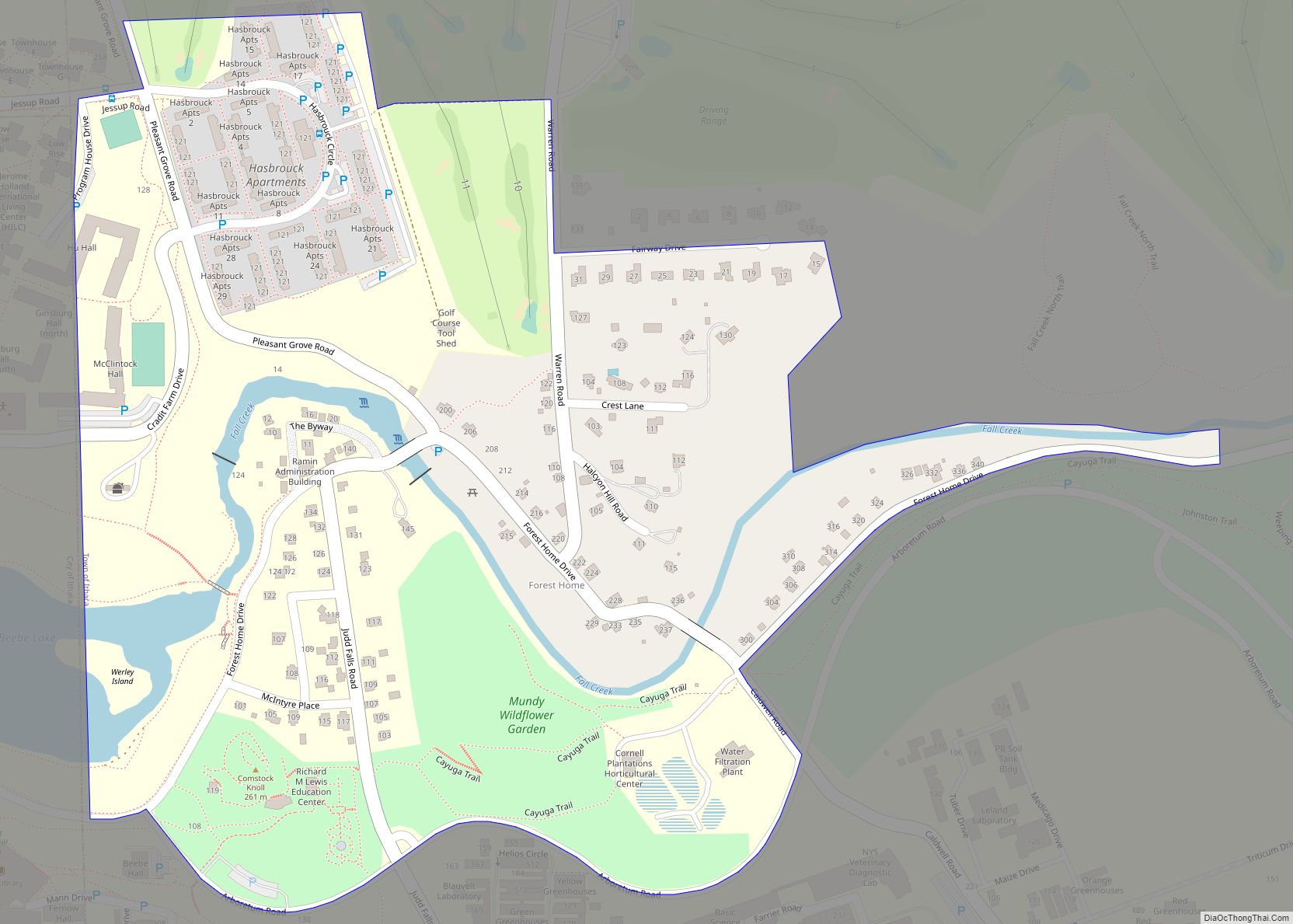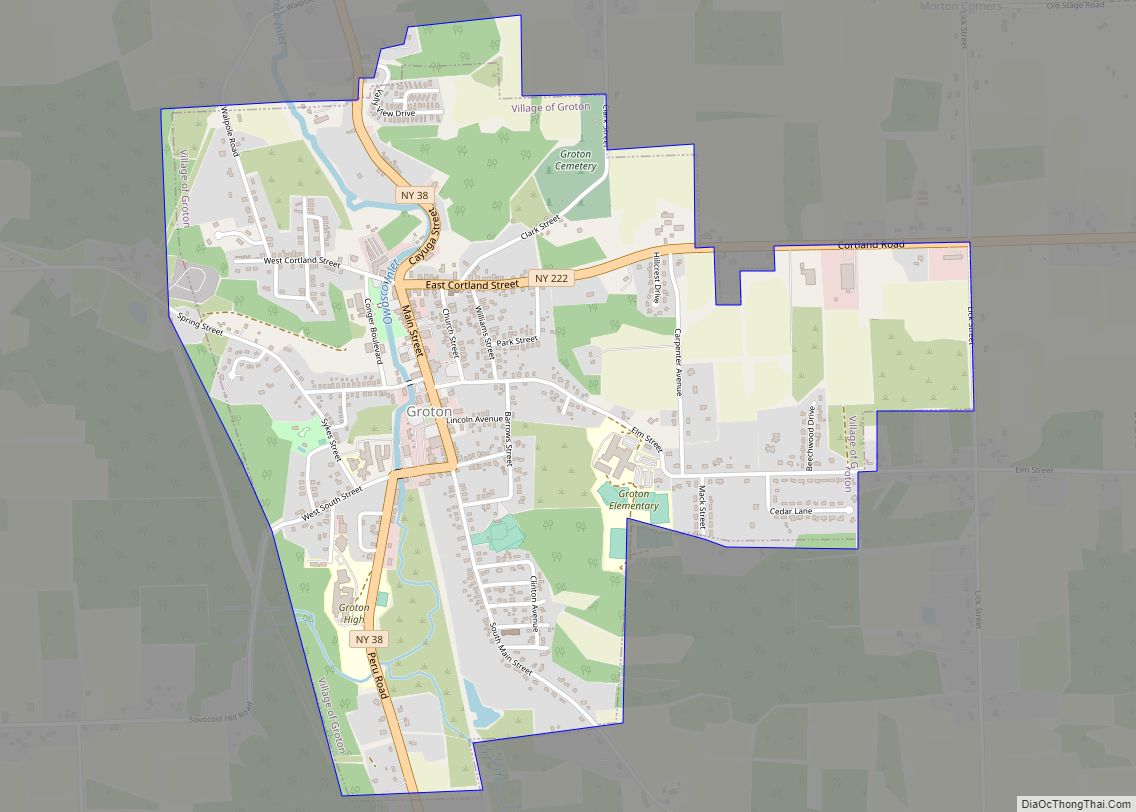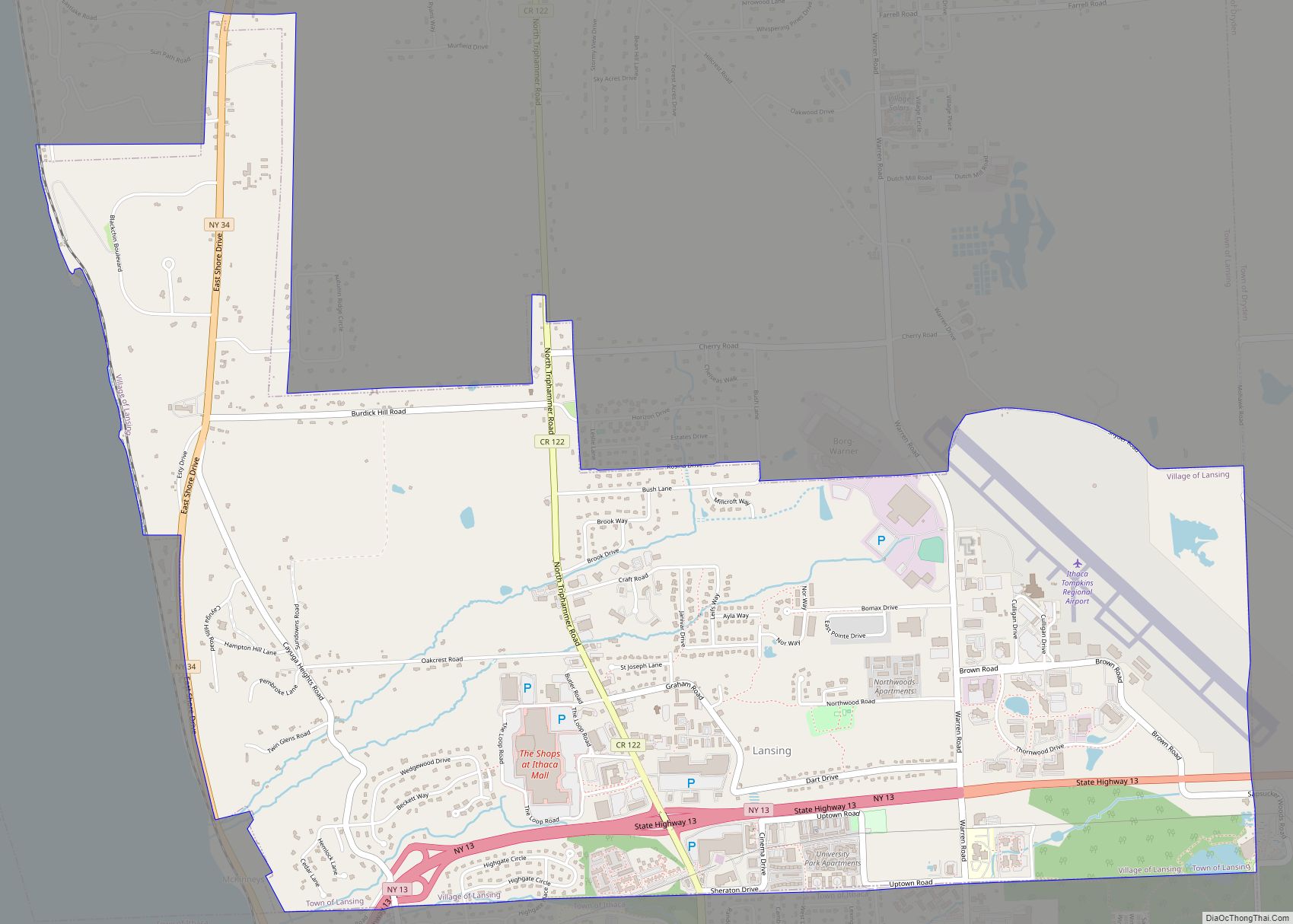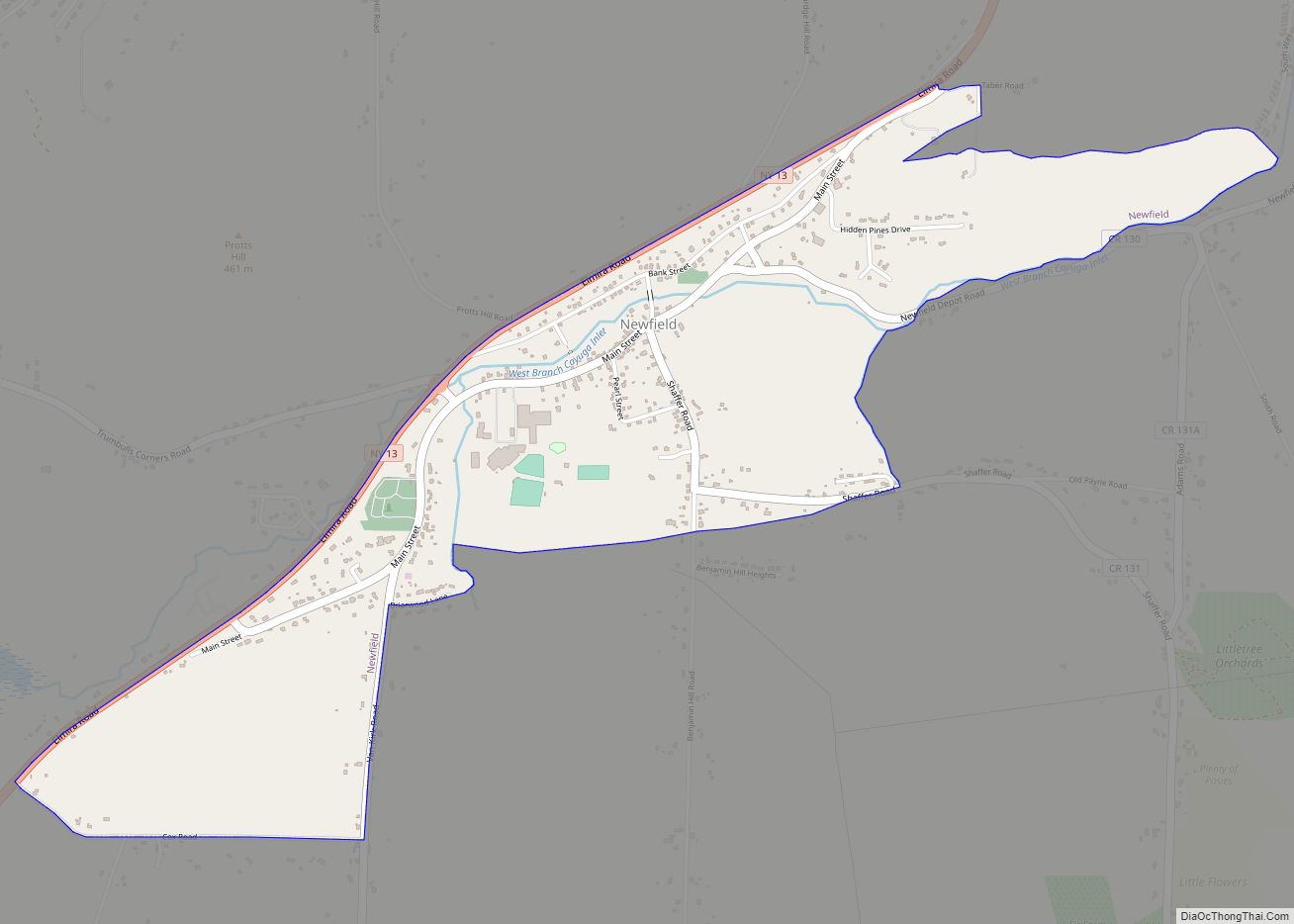Ithaca /ˈɪθəkə/ is a city and the county seat of Tompkins County, New York. Situated on the southern shore of Cayuga Lake in the Finger Lakes region of New York, Ithaca is the largest community in the Ithaca metropolitan statistical area. It is named after the Greek island of Ithaca.
A college town, Ithaca is home to Cornell University, an Ivy League university routinely ranked among the world’s best universities, and Ithaca College. Nearby in Dryden, New York is Tompkins Cortland Community College (TC3). These three colleges bring thousands of students to the area, who increase Ithaca’s seasonal population during the school year. As of 2020, the city’s population was 32,108.
| Name: | Ithaca city |
|---|---|
| LSAD Code: | 25 |
| LSAD Description: | city (suffix) |
| State: | New York |
| County: | Tompkins County |
| Founded: | 1790; 233 years ago (1790) |
| Incorporated: | 1888; 135 years ago (1888) |
| Elevation: | 404 ft (123 m) |
| Land Area: | 5.39 sq mi (13.96 km²) |
| Water Area: | 0.68 sq mi (1.77 km²) |
| Population Density: | 5,958.06/sq mi (2,300.47/km²) |
| Area code: | 607 |
| FIPS code: | 3638077 |
| Website: | www.cityofithaca.org |
Online Interactive Map
Click on ![]() to view map in "full screen" mode.
to view map in "full screen" mode.
Ithaca location map. Where is Ithaca city?
History
Early history
Native Americans lived in this area for thousands of years. When reached by Europeans, this area was controlled by the Cayuga tribe of Indians, one of the Five Nations of the Haudenosaunee or Iroquois League. Jesuit missionaries from New France (Quebec) are said to have had a mission to convert the Cayuga as early as 1657.
Saponi and Tutelo peoples, Siouan-speaking tribes, later occupied lands at the south end of Cayuga Lake. Dependent tributaries of the Cayuga, they had been permitted to settle on the tribe’s hunting lands at the south end of Cayuga Lake, as well as in Pony (originally Sapony) Hollow of what is known as present-day Newfield, New York. Remnants of these tribes had been forced from Virginia and North Carolina by tribal conflicts and European colonial settlement. Similarly, the Tuscarora people, an Iroquoian-speaking tribe from the Carolinas, migrated after defeat in the Yamasee War; they settled with the Oneida people and became the sixth nation of the Haudenosaunee, with chiefs stating the migration was complete in 1722.
During the American Revolutionary War, four of the then six Iroquois nations helped the British attempt to crush the revolution, although bands made decisions on fighting in a highly decentralized way. Conflict with the rebel colonists was fierce throughout the Mohawk Valley and western New York. In retaliation for conflicts to the east and resentment at the way in which the Iroquois made war, the 1779 Sullivan Expedition was conducted against the Iroquois in the west of the state, destroying more than 40 villages and stored winter crops and forcing their retreat from the area. It destroyed the Tutelo village of Coregonal, located near what is now the junction of state routes 13 and 13A just south of the Ithaca city limits. Most Iroquois were forced from the state after the Revolutionary War, but some remnants remained. The state sold off the former Iroquois lands to stimulate development and settlement by non-indigenous Americans; lands were also granted as payment to veterans of the war.
Within the current boundaries of Ithaca, Native Americans maintained a temporary hunting camp at the base of Cascadilla Gorge. In 1788, eleven men from Kingston, New York, came to the area with two Delaware people (Lenape) guides, to explore what they considered wilderness. The following year Jacob Yaple, Isaac Dumond, and Peter Hinepaw returned with their families and constructed log cabins. That same year Abraham Bloodgood of Albany obtained a patent from the state for 1,400 acres, which included all of the present downtown west of Tioga Street. In 1790, the federal government and state began an official program to grant land in the area, known as the Central New York Military Tract, as payment for service to the American soldiers of the Revolutionary War, as the government was cash poor. Most local land titles trace back to these Revolutionary war grants. However, the Bloodgood tract was not part of the state bounties to veterans. It was granted originally to a member of the state militia, Martinus Zielie, as a bounty under a different law for recruiting men to enlist in the Continental Army.
Partition of Military Tract
As part of this process, the Central New York Military Tract, which included northern Tompkins County, was surveyed under the direction of Simeon De Witt, Bloodgood’s son-in-law and the Surveyor General of New York. Simeon commissioned his first cousin, Moses De Witt (after whom DeWitt, New York, Is named) to survey the area around the south end of Cayuga Lake. Both Simeon and Moses were first cousins of DeWitt Clinton through his mother, Mary De Witt, who married James Clinton, brother of Governor George Clinton. The Commissioners of Lands of New York State (chairman Gov. George Clinton) met in 1790. The Military Tract township in which Ithaca is located was named the Town of Ulysses. A few years later De Witt moved to Ithaca, then called variously “The Flats,” “The City,” or “Sodom”; he renamed it for the Greek island home of Ulysses in the spirit of the multitude of settlement names in the region derived from classical literature, such as Aurelius, Ovid, and especially of Ulysses, New York, the town that contained Ithaca at the time.
Around 1791, De Witt surveyed what is now the downtown area into lots and sold them at modest prices. That same year John Yaple built a grist mill on Cascadilla Creek. The first frame house was erected in 1800 by Abram Markle. In 1804, the village had a postmaster and, in 1805, a tavern.
Growth
Ithaca became a transshipping point for salt from curing beds near Salina, New York, to buyers south and east. This prompted construction in 1810 of the Owego Turnpike. When the War of 1812 cut off access to Nova Scotia gypsum, used for fertilizer, Ithaca became the center of trade in Cayuga gypsum. The Cayuga Steamboat Company was organized in 1819 and, in 1820, launched the first steamboat on Cayuga Lake, the Enterprise. In 1821, the village was incorporated at the same time the Town of Ithaca was organized and separated from the parent Town of Ulysses. In 1834, the Ithaca and Owego Railroad’s first (horse-drawn) train began service, connecting traffic on the east–west Erie Canal (completed in 1825) with the Susquehanna River to the south to expand the trade network.
With the depression of 1837, the Ithaca and Owego Railroad was re-organized as the Cayuga and Susquehanna Railroad. It was re-engineered with switchbacks downhill into Ithaca in the late 1840s. In the late 20th century, a short section of its abandoned right-of-way in the City and Town of Ithaca was used for the South Hill Recreation Way.
However, easier early railroad routes were constructed that bypassed Ithaca, such as that of the Syracuse, Binghamton & New York (1854). In the decade following the Civil War, railroads were built from Ithaca to the surrounding points of Auburn; Geneva; Cayuga; Cortland; Elmira, New York and Athens, Pennsylvania, mainly with financing from Ezra Cornell. These were all branch-lines, as the geography of the city, on a steep hill by the lake, had prevented it from being directly connected to a major transportation artery. Several decades later, when the Lehigh Valley Railroad built its main, double-track freight line from Van Etten Junction to Geneva (and on to Buffalo, New York), opened in 1892, it bypassed Ithaca and Auburn to the west (running via Burdett and eastern Schuyler County on easier grades), as the Delaware, Lackawanna and Western Railroad had also done with its own, new Binghamton-Buffalo mainline extension to the south and west, via Owego, Waverly, Bath and Dansville, in 1882. Two of three daily New York-Buffalo round-trip passenger trains served Ithaca on the older, original LV “Ithaca Branch” between Van Etten Junction and Geneva, until discontinuance of the “Black Diamond” daylight train, on May 11, 1959. On May 25, 1959, the overnight “Maple Leaf” train was shifted back to the Ithaca Branch from the main line via Burdett, and operated on this route until the LV discontinued this last passenger service on February 4, 1961.
In the late 19th century, more industry developed in Ithaca. In 1883, William Henry Baker and his partners started the Ithaca Gun Company, making shotguns. The original factory was located in the Fall Creek neighborhood of the city, on a slope later known as Gun Hill, where the nearby waterfall supplied the main source of energy for the plant. The company became an icon in the hunting and shooting world, its shotguns famous for their fine decorative work. Wooden gunstocks with knots or other imperfections were donated to the high school woodworking shop to be made into lamps. John Philip Sousa and trick-shooter Annie Oakley favored Ithaca guns. In 1937, the company began producing the Ithaca 37, based on a 1915 patent by noted firearms designer John Browning. Its 12-gauge shotguns were the standard used for decades by the New York City Police Department and Los Angeles Police Department.
In 1885, Ithaca Children’s Home was established on West Seneca Street. The orphanage had two programs at the time: a residential home for both orphaned and destitute children, and a day nursery. The village established its first trolley in 1887. Ithaca developed as a small manufacturing and retail center and was incorporated as a city in 1888. The largest industrial company in the area was Morse Chain, elements of which were absorbed into Emerson Power Transmission on South Hill and Borg Warner Automotive in Lansing, New York.
Ithaca claims to be the birthplace of the ice cream sundae, created in 1892 when fountain shop owner Chester Platt “served his local priest vanilla ice cream covered in cherry syrup with a dark candied cherry on top. The priest suggested the dessert be named after the day, Sunday—although the spelling was later changed out of fear some would find it offensive.” The local Unitarian church, where the priest, Rev. John Scott, preached, has an annual “Sundae Sunday” every September in commemoration. Ithaca’s claim has long been disputed by Two Rivers, Wisconsin. Also in 1892, the Ithaca Kitty became one of the first mass-produced stuffed animal toys in the United States.
In 1903, a typhoid epidemic resulting from poor sanitation infrastructure devastated the city. Not having access to unpolluted water was one suspicion to the cause of the outbreak because “[r]efuse and the contents of the early sewer system dumped directly into the inlet”. One out of ten citizens fell ill or died. Local residents lost fifty-one people to the illness that year, but there was “an average of thirty-nine cases each year” for the consecutive ten years following.
In 1900, Cornell anatomy professor G. S. Moler made an early movie using frame-by-frame technology. For The Skeleton Dance, he took single-frame photos of a human skeleton in varying positions, giving the illusion of a dancing skeleton. During the early 20th century, Ithaca was an important center in the silent film industry. These films often featured the local natural scenery. Many of these films were the work of Leopold Wharton and his brother Theodore; The Wharton Studio was on the site of what is now Stewart Park.
The Star Theatre on East Seneca Street was built in 1911 and became the most popular vaudeville venue in the region. Wharton movies were also filmed and shown there. After the film industry centralized in Hollywood, production in Ithaca effectively ceased. Few of the silent films made in Ithaca have been preserved.
After World War II, the Langmuir Research Labs of General Electric developed as a major employer; the defense industry continued to expand. GE’s headquarters were in Schenectady, New York, to the northeast in the Mohawk Valley.
Although Ithaca has a history of Ku Klux Klan activity, including a cross-burning in 1923 and 1924, “the peak years of Klan activity in Ithaca were 1923-1925” and it represented only a fraction of the population. Ithaca is known for its political activism regarding civil rights and environmental issues. “Martin Luther King Jr. came to speak twice in Ithaca, in 1960 and 1961”. The annual Ithaca Festival, which often takes place on the Ithaca Commons or Stewart Park, frequently centers around themes promoting “a political statement into a cultural and festive event”
Recent history
For decades, the Ithaca Gun Company tested their shotguns behind the plant on Lake Street; the shot fell into the Fall Creek gorge at the base of Ithaca Falls. Lead accumulated in the soil in and around the factory and gorge. A major lead clean-up effort sponsored by the United States Superfund took place from 2002 to 2004, managed through the Environmental Protection Agency. The old Ithaca Gun building has been dismantled. It was scheduled to be replaced by the development of an apartment complex on the cleaned land.
The former Morse Chain company factory on South Hill, now owned by Emerson Power Transmission, was the site of extensive groundwater and soil contamination from its industrial operations. Emerson Power Transmission has been working with the state and South Hill residents to determine the extent and danger of the contamination and aid in cleanup.
In 2004, Gayraud Townsend, a 20-year-old senior in Cornell’s School of Industrial and Labor Relations, was sworn in as alderman of the city council: the first black male to be elected to the council and the youngest African American to be elected to office in the United States. He served his full term and has mentored other student politicians. In 2011 Cornell Class of 2009 graduate Svante Myrick was elected as the youngest mayor of the city of Ithaca.
Ithaca Road Map
Ithaca city Satellite Map
Geography
Geography
The valley in which Cayuga Lake is located is long and narrow with a north–south orientation. Ithaca is located at the southern end (the “head”) of the lake, but the valley continues to the southwest behind the city. Originally a river valley, it was deepened and widened by the action of Pleistocene ice sheets over the last several hundred thousand years. These ice sheets gouged the land crosswise to preexisting streams, producing hanging valleys. Once the last ice sheets receded — around twenty or thirty thousand years ago — these streams cut deep into the steep hillsides, forming the many distinctive gorges, rapids, and waterfalls seen in the region; examples include Fall and Cascadilla Creeks in Ithaca, and nearby Buttermilk Falls, Enfield Gorge, and Taughannock Falls. Cayuga Lake is the most recent lake in a long series of lakes which developed as the ice retreated northward. The lake drains to the north, and was formed behind a dam of glacial debris called a moraine.
Rock in the region is predominantly Devonian shale and sandstone. North of Ithaca, it is relatively fossil rich. The world-renowned fossils found in this area can be examined at the Museum of the Earth. Glacial erratics can also be found in the area.
Ithaca was founded on flat land just south of the lake — land that formed in fairly recent geological times when silt filled the southern end of the lake. The city ultimately spread to the adjacent hillsides, which rise several hundred feet above the central flats: East Hill, West Hill, and South Hill. The Cornell campus is loosely bounded to the north and south by Fall and Cascadilla Creeks, respectively.
The natural vegetation of the Ithaca area is northern temperate broadleaf forest. It is dominated by deciduous trees, including maple, sycamore, black walnut, birch, and oak; coniferous trees include white pine, Norway spruce, and eastern hemlock. The city of Ithaca has a rich diversity of tree plantings, with over 190 species, including cherry, southern magnolia, and ginkgo. In addition to visual beauty, this species diversification helps reduce the impact of arboreal epidemics, such as that caused by the emerald ash borer.
Climate
According to the Köppen climate classification method, Ithaca experiences a warm-summer humid continental climate, also known as a hemiboreal climate (Dfb). Summers are warm but brief, and it is cool-to-cold the rest of the year, with long, snowy winters; an average of 67 in (170 cm) of snow falls per year. In addition, frost may occur any time of year except mid-summer.
Winter is typically characterized by freezing temperatures, cloudy skies and light-to-moderate snows, with some heavier falls; the largest snowfall in one day was 26.0 in (66 cm) on February 14, 1914. But the season is also variable; there can be short mild periods with some rain, but also outbreaks of frigid air with night temperatures down to −10 °F (−23 °C) or lower. Summers usually bring sunshine, along with moderate heat and humidity, but also frequent afternoon thunderstorms. Nights are pleasant and sometimes cool. Occasionally, there can be heatwaves, with temperatures rising into the 90 °F (32 °C) to 95 °F (35 °C) range, but they tend to be brief.
The average date of the first freeze is October 5, and the average date of the last freeze is May 15, giving Ithaca a growing season of 141 days. The average date of the first and last snowfalls are November 12 and April 7, respectively. The hardiness zone is between 5b and 6a. Extreme temperatures range from −25 °F (−32 °C) as recently as February 2, 1961, up to 103 °F (39 °C) on July 9, 1936.
The valley flatland has slightly cooler weather in winter, and occasionally Ithaca residents experience simultaneous snow on the hills and rain in the valley. The phenomenon of mixed precipitation (rain, wind, and snow), common in the late fall and early spring, is known tongue-in-cheek as ithacation to many of the local residents.
Due to the microclimates created by the impact of the lakes, the region surrounding Ithaca (Finger Lakes American Viticultural Area) experiences a short but adequate growing season for winemaking similar to the Rhine Valley wine district of Germany. As such, the region is home to many wineries.
See also
Map of New York State and its subdivision:- Albany
- Allegany
- Bronx
- Broome
- Cattaraugus
- Cayuga
- Chautauqua
- Chemung
- Chenango
- Clinton
- Columbia
- Cortland
- Delaware
- Dutchess
- Erie
- Essex
- Franklin
- Fulton
- Genesee
- Greene
- Hamilton
- Herkimer
- Jefferson
- Kings
- Lake Ontario
- Lewis
- Livingston
- Madison
- Monroe
- Montgomery
- Nassau
- New York
- Niagara
- Oneida
- Onondaga
- Ontario
- Orange
- Orleans
- Oswego
- Otsego
- Putnam
- Queens
- Rensselaer
- Richmond
- Rockland
- Saint Lawrence
- Saratoga
- Schenectady
- Schoharie
- Schuyler
- Seneca
- Steuben
- Suffolk
- Sullivan
- Tioga
- Tompkins
- Ulster
- Warren
- Washington
- Wayne
- Westchester
- Wyoming
- Yates
- Alabama
- Alaska
- Arizona
- Arkansas
- California
- Colorado
- Connecticut
- Delaware
- District of Columbia
- Florida
- Georgia
- Hawaii
- Idaho
- Illinois
- Indiana
- Iowa
- Kansas
- Kentucky
- Louisiana
- Maine
- Maryland
- Massachusetts
- Michigan
- Minnesota
- Mississippi
- Missouri
- Montana
- Nebraska
- Nevada
- New Hampshire
- New Jersey
- New Mexico
- New York
- North Carolina
- North Dakota
- Ohio
- Oklahoma
- Oregon
- Pennsylvania
- Rhode Island
- South Carolina
- South Dakota
- Tennessee
- Texas
- Utah
- Vermont
- Virginia
- Washington
- West Virginia
- Wisconsin
- Wyoming
